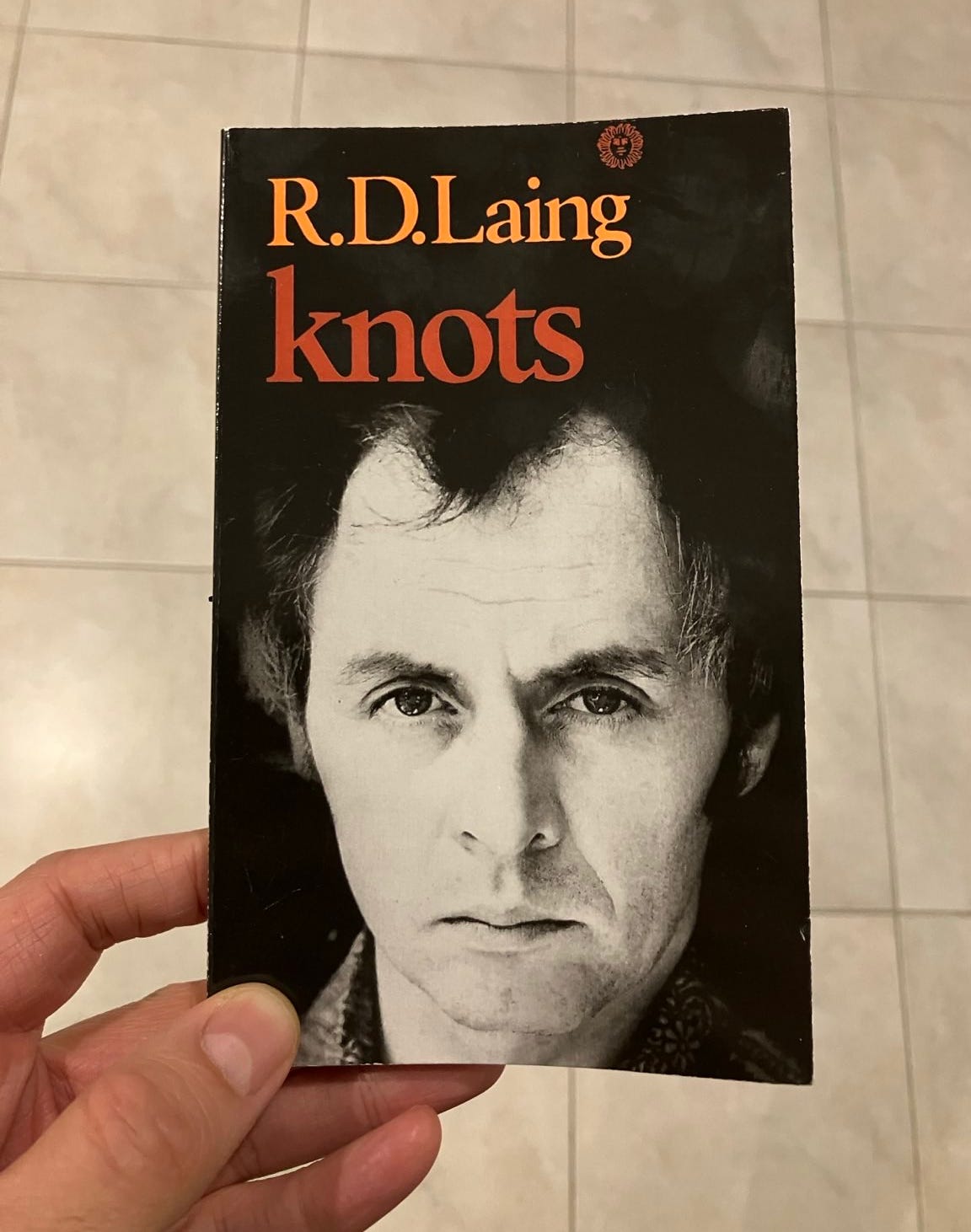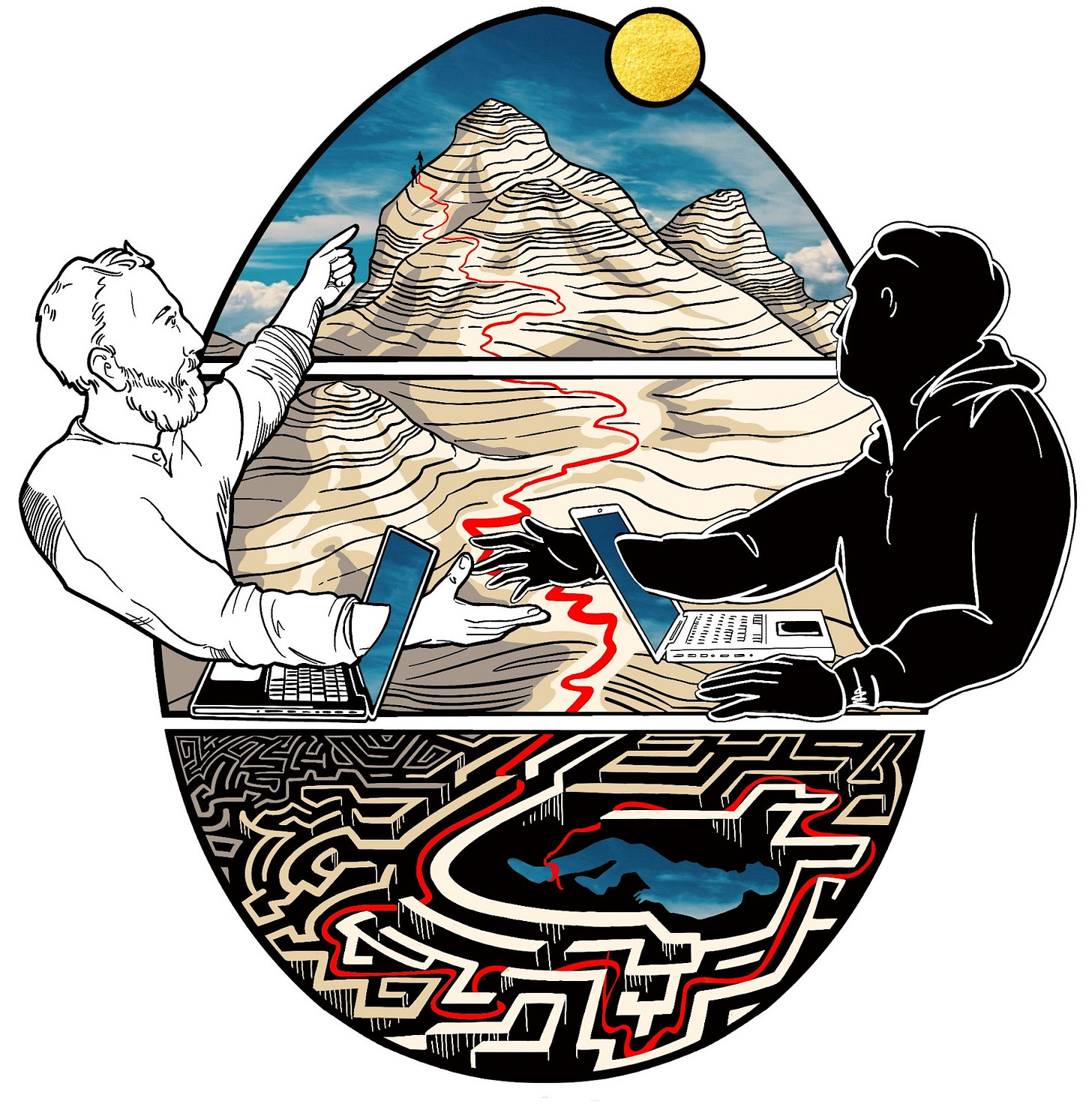Existentially Knotty
I have a mysterious, esoteric inquiry practice that I can’t quite find the right name for (basically, I just say “I do coaching” when speaking with normal people). My specialty is untying what I call “existential knots” (x-knots).
I originally defined an x-knot as:
An existential knot is an issue that feels deeply personal, most saliently experienced as a felt sense, and accompanied by great difficulty in coherently describing what the issue actually is. The person’s mental models are extremely entangled, with thought loops that lead to difficult emotions. When they try to “solve” the issue, they are met with disappointment and confusion. When they inquire into it on their own, they encounter frustration and a sense of stuckness. A common reaction is to escape into some form of coping. If the existential knot remains tied, an “existential crisis” follows.
Or, more simply:
Being deeply confused about something that feels deeply important, without feeling like you can accurately articulate what the confusion or the importance is.
The big three x-knot inquiries I most frequently encounter:
Meaning of life confusions (See: “Three Ways to Escape Philosophical Confusion”)
Relationship confusions (See: “Who Are You Living For?”)
Livelihood confusions (See: “Seven Ways to Close the Vocation Gap”)
An x-knot can also be something small and seemingly inconsequential, like a passing comment that triggered you. In my 2x2 “space holder” taxonomy, which includes “inquiry genres” such as philosophical counsellors, psychotherapists, life coaches, and spiritual guides, I would place untying x-knots on the reflective axis, which weaves between masculine (propositional truth claims) and feminine (nebulous emotional realities) ways of understanding an issue.
In contrast, another term I have been using lately is “existential projects,” which I defined as “something that feels important to one’s existence, with actionable behaviours that lead to real-world skills or accomplishments.” An x-project has vocational significance, with tangible things to accomplish. It includes a mix of masculine (something hard: a will to overcome challenging obstacles) and feminine (something easy: an inner knowing that puts you on the path of unknowing) aspects as well.
I wrote about a personal x-project in my recent entry on overcoming public speaking anxiety, which serves as a good example of what I mean. Untying x-knots leads to pursuing x-projects, and pursuing the latter reveals more of the former. However, when things get too existentially knotty, one stops acting toward what makes them come alive, and what brings life more generally, and they begin to feel stuck. There is a great stuckness that many feel today. It’s gotten so bad that even Oprah created an “unstuck journal.”
The problem with the self-help scene and life coaches (and their fallacies) is that they prematurely name the problem, offer a solution, and then sell you (manipulate you) through various marketing tactics. Going into solution mode too early is not wise, which is something my new friend Tony Robbins tends to do. Instead, one has to have the courage to stay with the bother and integrate emotional parts while cohering their reasoning.
I thought this x-knot framing was original coinage from me, but I recently discovered that the late, great R.D. Laing beat me to it …
Laing was a controversial anti-psychiatrist who worked with schizophrenics and saw their dis-ease as something sane responding to something insane: the world. He wrote his book Knots later in his life and expressed various “knots” as poetic polysyllogisms. Here is the one the book starts with …
They are playing a game. They are playing at not playing a game. If I show them I see they are, I shall break the rules and they will punish me. I must play their game, of not seeing I see the game.
Totally illogical. Totally relatable. Another …
I don’t feel good
therefore I am bad
therefore no one loves me.
I feel good
therefore I am good
therefore everyone loves me.
I am good
You do not love me
therefore you are bad. So I do not love you.
I am good
You love me
therefore you are good. So I love you.
I am bad
You love me
therefore you are bad.
My favourite one:
There is something I don’t know
that I am supposed to know.
I don’t know what it is I don’t know,
and yet am supposed to know,
and I feel I look stupid
if I seem both not to know it
and not know what it is I don’t know.
Therefore I pretend I know it.
This is nerve-racking
since I don’t know what I must pretend to know.
Therefore I pretend to know everything.
I feel you know what I am supposed to know
but you can’t tell me what it is
because you don’t know that I don’t know what it is.
You may know what I don’t know, but not
that I don’t know it,
and I can’t tell you. So you will have to tell me everything.
🤯
[Relatedly, the next time you see me acting extra stoic while listening to a galaxy brain speak at The Stoa, you’ll know the above x-knot is active.]
This book is not meant to be a formal taxonomy of different x-knots. Rather, it’s a poetic mapping between the inner wilderness of one’s emotional landscape and their logical space, which, when seen in propositional form, appears completely illogical.
In my experience, accessing and honouring what one actually feels to be true, then putting words to it while still staying in contact with the feeling, is transformational. It can also be translational, moving from emotion to proposition.
Somatic therapists, arguably the most effective form of therapy (or at least among the more popular ones in today’s wisdom spaces), often skip this step and seek instead to integrate the unmet emotion directly. While effective, this approach forgoes the opportunity to address muddled reasoning and begin to cohere it. Why not do both? Integrate the emotion and cohere the reasoning.
I doubt one can wisely navigate the complexity of life without the ability to reason coherently. Given that schooling fails to impart such skills, and there are few public spaces for this kind of inquiry, I feel called to create them, whether through The Stoa and sessions like Collective Journalling or in my unnamable inquiry practice.
My friend
created the image below, which illustrates what my practice typically involves …The bottom, darker half of the illustration represents x-knots, and the upper, brighter half represents x-projects.
An inquiry usually starts by sensing where my interlocutor feels stuck, which is where all their x-knots lurk in the subterranean realm. Then comes the slow untying, or what Sigmund Freud calls “working through,” which takes time and space. Once enough x-knots are untied, one’s x-projects begin to reveal themselves. Aliveness emerges, and with it, a new lease on life.
Everyone I meet is so existentially knotty, especially those who focus on addressing existential risks (x-risks): global threats that could lead to the collapse of the human project or, worse, its extinction. Examples include nuclear war, unaligned AI, or engineered pandemics.
I am daring to venture into the belly of the rationalist beast, LessWrong, whose primary concern is addressing x-risks, and make this argument to them:
X-knots left tied lead to unresolved x-risks.
If I do, I’ll repost it here, and if you have any thoughts on how to land this argument so they can understand it, and more importantly, feel it, let me know…
Christian Appendix
While writing this entry at Collective Journaling, someone introduced me to Mary, Untier of Knots, a Catholic devotion to the Virgin Mary.
The devotion focuses on Mary resolving intractable personal problems or “knots.” It was inspired by a 17th-century Baroque painting by Johann Georg Melchior Schmidtner.
The purpose of the devotion is to entrust one’s knots to Mary and ask her to untie them with wisdom. It is a novena, meant to be prayed over nine consecutive days. It also includes various individual prayers...
Mother of fair love, I look to you.
Take into your hands the ribbon of my life,
and see the snarl of knots that keeps me bound
to sin, anxiety, and hopelessness.
I beg you, Mother, by your powerful intercession
and long fingers of love and grace,
undo the knots in my heart and in my life.
Free me to love as Christ loves.
Mary, Undoer of Knots, pray for us.
Since my Christian turn at the tail end of last summer, I have been praying. From an Orthodox perspective, prayer is aligning one’s will to God. I like to contrast this with magick, which is aligning one’s will to ego.
I find the combination of prayer and inquiry powerful. The former aligns; the latter coheres. In my foolishness, I used to think I could rely solely on inquiry, as if it were magic. I was getting quite good at it and was using it to untie my own knots. This inquiry prowess led to arrogance. I thought all I needed was me—the self, my mind, and my will—to address what was knotting me up.
However, there are some challenges one simply cannot overcome alone. And when one complexifies themselves past a certain point, it becomes more difficult for others to truly understand them or hold space for them. In these cases, something beyond the self is needed.
Releasing my arrogance and putting things in God’s hands has eased my body to a great degree: the Spirit of peace is here. I’ll play my part, but I no longer have to hold all the weight myself.
The Stoa’s website has made a come back …
Give it a visit to RSVP for upcoming public events, including Collective Journalling: a place where we journal together, in silence, with music. It’s a great place to cohere your reasoning. You can listen to its theme song and get a sense of its vibe here:
If you’d like an opportunity for one-on-one cohering, you can reach out to me at thestoa at protonmail dot com for a philosophical inquiry. Email me about why you feel called to inquire and how you sense I can be of service.
This playlist still captures the vibe of such sessions:








